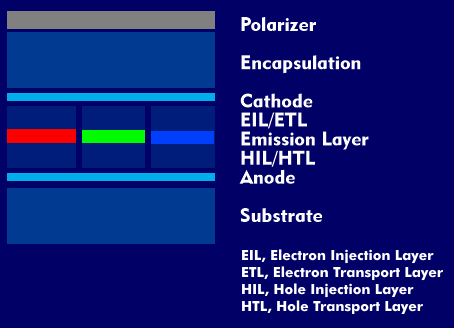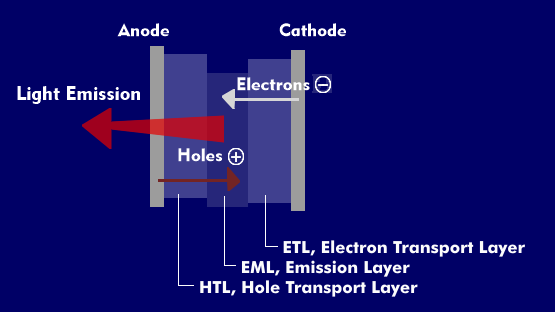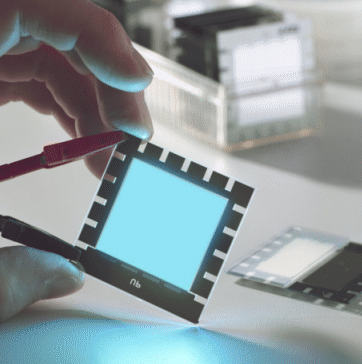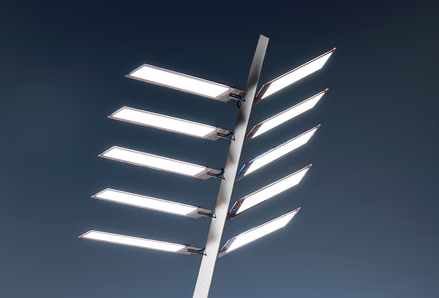organic light emitting diode (OLED)
Organic Light Emitting Diode (OLED) is a further development of the light emitting diode( LED) for display technology. Unlike LEDs, the colored self-luminous OLEDs consist of organic semiconductors that emit light in an electric field.
The structure of OLEDs
OLEDs are multilayer surface emitters consisting of several organic layers that provide for the transport of holes and electrons, as well as for their recombination, which leads to light emission. The various layers lie on a transparent substrate - glass or transparent plastic - on which an extremely thin, transparent, electrically conductive oxide layer, Transparent Conductive Oxide( TCO), made of indium tin oxide( ITO), is deposited. This layer forms the anode.
The anode is at positive potential, the cathode at negative. Between the cathode and the anode are other layers: The Electron Injection Layer( EIL) with the electron conduction layer, Electron Transport Layer( ETL). Below this is the light-emitting polymer layer, the Emission Layer( EML), and below this in turn is the Hole Injection Layer( HIL) and the associated Hole Transport Layer( HTL). False electrons (holes) and electrons act as charge carriers.
The cathode generates the electrons, which are injected via the Electron Injection Layer (EIL) and drift to the EML layer via the Electron Transport Layer (ETL). In the Emission Layer (EML), an organic light emitting polymer layer, the electrons and the holes recombine to form an electron-hole pair, an exciton. The holes are injected from the hole injection layer (HIL) and, due to the voltage potential between the anode and cathode, also drift through the hole transport layer (HTL) toward the emission layer (EML). When the electrons recombine with the holes, they emit photons as visible light in the indium tin oxide (ITO) coated glass substrate.
The light generated in this way passes through the transparent substrate to the display surface. The material of the polymer layer determines the color of the light. Thus, polythiophene glows red, polyfluorine blue and polyphenylene vinyl green.
The most important properties of OLEDs
In terms of their electrical properties, OLEDs are quite comparable to conventional diodes. When no voltage is applied, only low reverse currents flow. Only when a certain threshold voltage of a few volts is reached does the multilayer surface emitter become permeable and the current increases rapidly. This function is important because the OLEDs do not require any current in the non- active state and appear black. The operating voltage is between 5 V and 10 V and the current density is between a few milliamps and one ampere per square centimeter.
OLEDs are characterized by high luminance and good contrast, which can have a ratio of up to 1 million to 1. They can also display grayscale. Their power consumption is proportional to the luminous flux, they are self-luminous, flexible, extremely flat and have a high resolution with a pixel size of 5 µm, which is increased to about 0.1 mm by the control lines for the transistors. Their switching speed is very short at about 10 µs, and they also offer an extreme viewing angle of up to 160°. Driven by an array of Organic Thin Film Transistors( OTFT), OLEDs form an OTFT display with the OTFT drive matrix.
Luminance and matrix concepts of OLEDs
Thanks to their luminosity, flexibility and low power consumption, OLEDs are ideal for displays. They consist of matrix-shaped arrays of active and passive OLEDs: Active Matrix OLEDs( AMOLED) and Passive Matrix OLEDs( PMOLED) and also transparent OLEDs, TOLED, flexible OLEDs, FOLED or plastic OLEDs, POLED. In addition, there are Phosphorescent Organic Light Emitting Diodes( PHOLED), which work with phosphorescence and have a higher light output. Corresponding OLED displays are used in mobile devices, in MP3 players, cell phones, PDAs, automobiles and smartphones, while larger displays are used in notebooks, desktops and televisions.
Furthermore, particularly bright OLEDs are being developed as lighting elements. The luminous efficacy is over 100 lm/W(lumens per watt), the luminous intensity can be up to 100,000 cd/m2( candela per square meter), the color rendering index( CRI) reaches values of up to 95 and the service life is over 10,000 operating hours. at 100 cd/sqm. These OLEDs are referred to as whiteOLEDs (WOLED). In comparison, incandescent lamps have a luminous efficacy of between 10 lm/W and 20 lm/W.
OLEDs are much easier and cheaper to produce than light-emitting diodes or Thin Film Transistors( TFT) and can also be manufactured in printed electronics. Their lifetime will increase from 10,000 hours in 2012 to about 40,000 hours in 2018. Lifetime is defined as a 30% decrease in brightness relative to the initial brightness.




